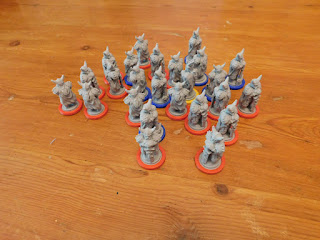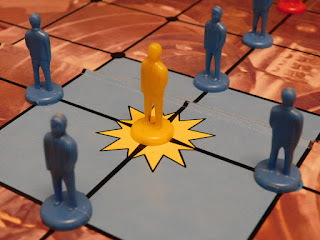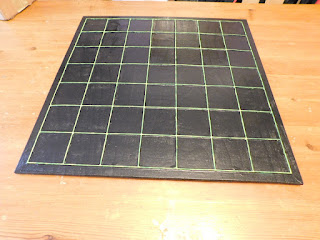I saw this set of Viking-style pieces for a 9 x 9 hnefatafl version on eBay, and because they are quite different from any other hnefatafl set I have in my collection, I got it.
Thursday, December 1, 2022
Viking tablut
Tuesday, November 1, 2022
Shannon Games hnefatafl
Quite recently, I blogged about a self-made hnefatafl game, which I called Ferengitafl. The starting array of that game was based on a commercial hnefatafl game, marketed by Shannon Board Games. At that moment in time, I only knew about this 'Shannon' hnefatafl from a picture and brief description on the internet. But lo and behold, very soon after publishing the blog post, a listing of the actual game appeared on eBay! Needless to say ...
Saturday, October 1, 2022
Goldfinger
Recently, I posted on my copy of a commercial version of hnefatafl, Swords and Shields, which dates back to 1970. A few years prior to that, in 1966, to be precise, a very similar game was released. This had a 'James Bond 007' theme, and was called 'Goldfinger'. The 'story' of the game is that James Bond and his agents have to prevent Goldfinger from escaping from the vault of Fort Knox.
Copies of the Goldfinger game do occasionally pop up on eBay, but the problem is that the listings invariably come from the US. On top of that, the prices asked, taking into account additional shipping charges and import duties, make it prohibitively expensive to get it from across the pond.
So patience was required, and patience finally did pay off, when an eBay listing for Goldfinger was UK-based .... Needless to say I snapped it up!
Thursday, September 1, 2022
'Ferengitafl'
Well over three years ago, I got myself a job lot of Star Trek micro-machines, and used many of these to create a set for Klin Zha. I didn't use all of them, and when I recently opened the box where the remaining ones were stored, I realised there were exactly enough of them to create a hnefatafl set ....
For the 'king side' I used Borg cubes and Terek Nor space stations as pieces and a Ferengi D'Kora Marauder as king:
Given the number of pieces, the board had to be a 9 x 9 board, and I chose to use matches to mark the squares.
If you're familiar with hnefatafl variants, you will be surprised that the kings side has six defenders rather than four or eight. This is purely because I didn't have more micro-machines I could use, but it also allowed me to model my set on a hnefatafl version marketed in the past by Shannon Board Games, which has six defenders against twelve attackers:
Monday, August 1, 2022
'Copenhagen Rules' hnefatafl
The details of the rules used for playing hnefatafl in Viking and Celtic times are mostly unknown, and have been reconstructed from what little evidence has come to us from those times. To avoid confusion and debate, modern hnefatafl tournaments are often played to a specific set of codified rules: the Copenhagen Rules.
I wanted to add a hnefatafl set to the collection which looked modern while at the same time capturing its Viking heritage. Searching the interwebs made me stumble across this 'Viking Chess' set.
Friday, July 1, 2022
Imperial Contest - interpretation of a 19th century game
As far as I'm aware, 'Imperial Contest' is the oldest commercial hnefatafl game. It dates back to 1855, and depicts the Crimean War, with England, Turkey, France and Sardinia facing Russia. I have never seen even a picture of the original 19th century game, but some information on it is here.
As I expect I will never have the chance to add an original copy of 'Imperial Contest' to my collection, I decided to create my own interpretation of it.
For the pieces I created flags, using carbon rods, plastic end caps and rubber washers, together with a bit of kite line. For the board, I chose chamois.



















































